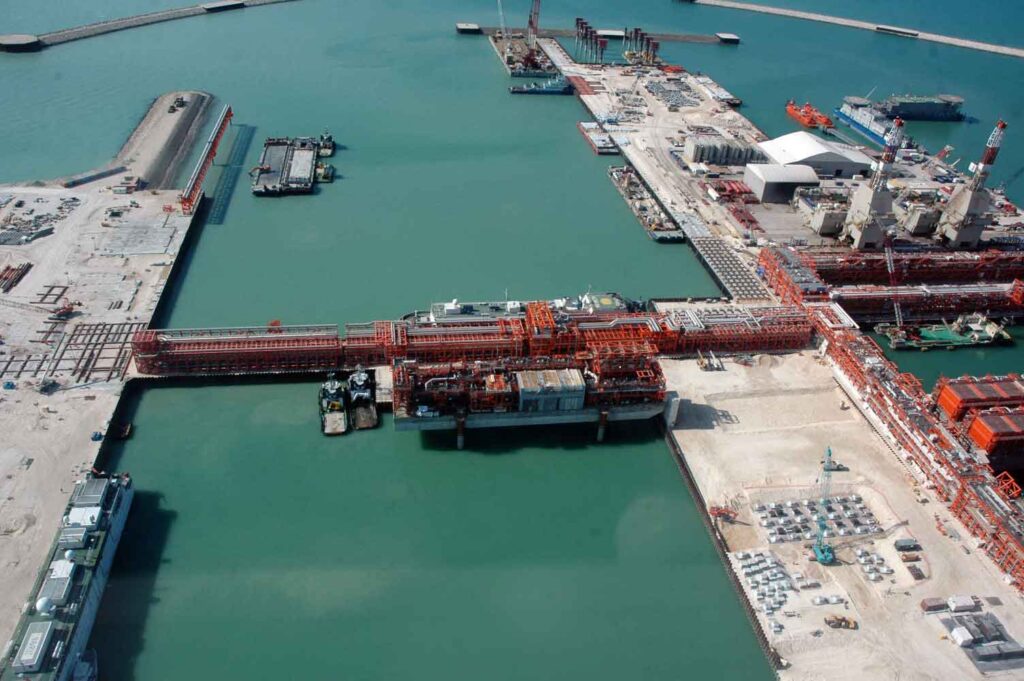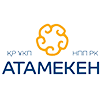
Recently it became known that the Ministry of Ecology and Natural Resources of the Republic of Kazakhstan filed a lawsuit against NCOC for 2.3 trillion tenge or $5.1 billion in fines for environmental pollution. Bloomberg reported that the Ministry accuses the Kashagan operator of storing twice as much sulfur as it is permitted.
Petrocouncil received access to the results of the audit carried out by the Department of Ecology for the Atyrau region.
According to the results of the environmental audit that was provided to Petrocouncil.kz, the inspectors identified several violations at NCOC facilities. In particular, there is a sulfur storage site on the territory of the Bolashak oil and gas treatment plant: six blocks with a capacity of 676 thousand tons each. As of November 1, 2022, over 1.7 million tons of sulfur have accumulated on these maps. Whereas the company was permitted to store no more than 730 thousand tons. Thus, according to the results of the inspection, the operator exceeded the quota by more than two times.
NCOC was only permitted for temporary store of sulfur in sulfur pads. However, experts of the Department of Ecology noted sulfur has not been sold and all volumes are placed without removal. According to NCOC last annual report, the company reported that during 2018-2021 it exported from 1 million to 1.2 million tons of sulfur annually.
The operator had to cover the sulfur stored in the open air with a special membrane. This was not done. Department of Ecology explains that the natural humidity falling into cracks that exist in sulfur blocks in reaction with the oxygen and organic substance create conditions for the formation of hydrogen sulfide under the open storage.
Sulfur was transported and loaded without dust suppression. Crushed sulfur from the place of loading to the railway station “Bolashak” was transported on vehicles not equipped for this purpose. The sulfur was not covered with a special material so that sulfur dust would not scatter through the air.
Also, according to the report, the Kashagan operator does not fulfill the environmental protection action plan in full and on time. For example, it does not fulfill its obligations to increase the reuse of water in production. The Department also identified that the operator was dumping wastewater into the evaporator pond without treatment and without an environmental permit.
Moreover, NCOC does not report on the implementation of environmental measures. In accordance with the terms of environmental management, the operator had to take measures to identify and eliminate sources of pollutants and continue comprehensive studies of atmospheric air quality in Atyrau city and at the border of the sanitary protection zone of the Bolashak plant. But these conditions are not fulfilled in 2022 at the proper level. Thus, according to the regulatory authority, NCOC does not fully comply with the conditions of the permit for emissions into the environment.
According to the requirements of the Environmental Code of the Republic of Kazakhstan, automated monitoring of emissions should be carried out from January 1, 2023 at facilities commissioned before July 1, 2021. However, NCOC plans to comply with the requirement of environmental legislation from 2026.
We go further through the pages of a detailed report and see the information about the elimination of the consequences of the accident that occurred at the Bolashak plant in August last year. If you remember, we wrote that the Bolashak plant was stopped due to the discovery of a gas leak at the slug catcher. This sludge trap separates the liquid from the gas coming from D Island. To quickly commission the plant, the operator converted the equipment on site without any design and approval for its use by the competent authorities.
Repair of the slugcatcher was carried out from August 25 to November 5 last year. At the same time, only 12 out of 24 pipelines of the equipment that ensured the separation of moisture from gas had not been removed and only one pipeline had not been not removed our of 24 pipelines that ensured the removal of moisture from the slug catcher. Despite this, NCOC specialists assured that the operation of the equipment was normal and did not adversely affect any installations. It is planned to return the slug catcher to the full working condition only in 2024.
During the accident there was an uncontrolled release of hazardous substances into the atmosphere in the form of sulfur dioxide in the amount of 842-1665 kg. During the the failure of the gas-liquid separator, 625 thousand cubic meters were burned at the Bolashak plant.
In addition, during the separator downtime, abnormally high volumes of sulfur dioxide were burned in the amount of 425 thousand cubic meters.
As Department of Ecology noted, it was not permitted by the MPE for 2022. Therefore, it was carried out without permission and was a violation of the requirements of the law.
Also, inspectors identified the emission of pollutants into the environment in the form of hydrogen sulfide without an environmental permit on the evaporation tanks of the railway complex of the western Eskene.
To date, administrative cases have been initiated against NCOC on the above-mentioned facts under six articles of theAdministrative Offenses Code of Kazakhstan. The case were submitted to the specialized administrative court of the city of Atyrau.
NCOC responded to Petrocouncil.kz that the operator has no information about the penalties associated with the storage of sulfur and the company carries out its sulfur management activities responsibly and in accordance with the laws of Kazakhstan, as well as in accordance with applicable standards and best practice.
Bloomberg, citing its sources, reports that the authorities’ demands for NCOC could be related to Kazakhstan’s desire to establish greater control over the project. This is demonstrated by the multibillion fine. In 2012, Kazakhstan obtained a 10% stake in the Karachaganak project as a result of the settlement of an economic dispute.
On April 11, new energy minister Almasdam Satkaliyev confirmed to the media that Kazakhstan had filed lawsuits in international court against the operators of Kashagan and Karachaganak for $16.5 billion ($13 billion and $3.5 billion, respectively).
Earlier, a Petrocouncil source close to NCOC shareholders indicated that a claim for $13 billion had accumulated between the operator and Kazakhstan. The relationship between the operator and the authorized body was very difficult and shareholders see unprecedented pressure from the Republic. After imposing a fine, as one of the options, the shareholders could consider to aks for a support from European countries, the European Parliament in resolving a dispute with the government of Kazakhstan. This may complicate relations with the European Union in this difficult geopolitical time. One potentially sensitive issue that could be raised by the EU is the issue of secondary sanctions.
The operator analyzes the negative consequences of the conflict with the authorities and supposes that the latter can use such pressure instruments as:
– lost profits associated with subsequent delay in production;
– further environmental audits;
– additional expenses related to the repair and replacement of pipelines;
In turn, if operator will see positive dynamics, the operator can support with the construction of the gas processing plant as well as speed up the preparation of technical documentation for the second phase of the project. But also the operator could demand to simplify the requirements for the coordination of technical processes and local content (equal rights for foreign and Kazakh contractors)
At the same time, a source in the Ministry of Ecology pointed to the government’s misunderstanding about the “leak” to Bloomberg by the operator and/or shareholders, thereby exacerbating the situation. The position of Kazakhstan was expressed in an exclusive interview with the General Director of PSA LLP Beket Izbastin to Petrocouncil.kz (https://petrocouncil.kz/eksklyuzivnoe-intervyu-generalnogo-direktora-too-psa-beketa-izbastina-neftegazovymu-sovetu-petrocouncil-kz-po-tekushhim-proekta-srp/ ).
Almost all Kazakhstani experts in the oil and gas industry expressed their thoughts on this topic. Some industry experts tend to speculate that the $5 bln. fine also matters, given the fact that the total budget for Kashagan Phase 2 is $10 bln. total (2A and 2B) and the refusal of NCOC to develop the 2B project.
It would also be interesting to know how this conflict is interpreted in Europe. We interviewed Benjamin Goodwin, director of analysis for UK-based PRISM Political Risk Management.
Benjamin believes that the natural consequence of such a dispute is that key investment decisions are likely to be put on hold until both parties agree. The Kashagan project and the government of Kazakhstan are planning a series of major investments that will increase oil production from 450,000 bpd to 710,000 bpd (Stage 2A and Phase 2B). Crucially, for Kazakhstan, this expansion will also produce needed gas for the country’s gasification program – up to 6 bcm. m of gas per year. He also tends to believe that it is not in the interests of any of the parties to delay these investments.

“I can’t speak about the validity of the ROK’s claims – this is yet to be determined – but there is little doubt that this action will be negatively perceived by the international investment community. We do not know the details of the negotiations between the two parties but from the point of view of a third party, the announcement of the fine came as a big shock. In recent years, there has been a strong perception that relationships between the investment community and the new administration have been good and that the government is working closely with investors to improve the investment climate.
This positive perception is especially important now, given that in recent years the task of attracting foreign investment in Kazakhstan has become more difficult, especially in the oil and gas industry. The global shift towards decarbonization has made major investors less focused to new offshore projects such as those in the Caspian Sea (capital intensive and long-investment return). Moreover, the political instability in the Republic of Kazakhstan in January 2022 and the wider geopolitical challenges that arose after February 24, 2022 exacerbated the view that Kazakhstan may no longer provide the political stability that it once did,” commented Benjamin Goodwin.
In our opinion, the issue requires negotiations since litigation can take years and may question the implementation of some projects. The case of KEP-1 KPO project demonstrated that the conflict between KPO and authorities delayed the development of the project for half a year.
For Kazakhstan, as well as for the business community, the implementation of new oil and gas projects at Kashagan and Karachaganak is very important, taking into account the commissioning of TCO FGP project. Therefore, foreign investment in the industry, their competencies are necessary. But it is also necessary to comply with environmental laws. Indeed, in the Europe environmental requirements are simply the most severe. The shareholders of Kashagan have already invested more than $50 billion and the partners in the Karachaganak project invested at least $27 billion and investments into new projects are very important for Kazakhstan.

